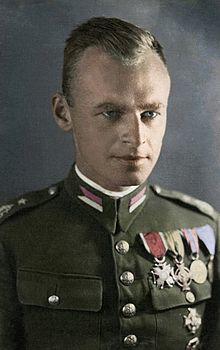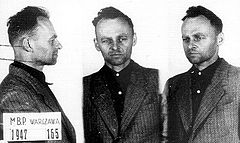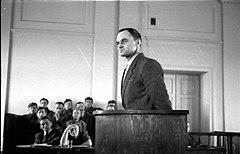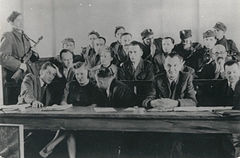Witold Pilecki | |
|---|---|
 Pilecki in a colorized pre-1939 photograph | |
| Born | 13 May 1901 Olonets, Olonetsky Uyezd, Olonets Governorate, Russian Empire |
| Died | 25 May 1948 (aged 47) Mokotów Prison, Warsaw, Poland |
| Buried | Unknown; possibly in Powązki Military Cemetery or Mokotów Prison |
| Allegiance | Second Polish Republic; Polish Government in Exile |
| Years of service | 1918–1947 |
| Rank | Captain, Cavalry master |
| Commands held | Commander of the 1st Lidsky Squadron (1932–1937)
|
| Battles/wars | Polish–Soviet War
|
| Awards |
|
| Alma mater | University of Poznań, Faculty of Agriculture (1922) Stefan Batory University, Faculty of Fine Arts (1922–1924) |
| Spouse(s) | Maria Ostrowska (m. 1931) |
| Children | 2 |
Witold Pilecki (13 May 1901 – 25 May 1948; Polish pronunciation: [ˈvitɔlt piˈlɛt͡skʲi]; codenames Roman Jezierski, Tomasz Serafiński, Druh, Witold) was a Polish cavalry officer, intelligence agent, and resistance leader. Early in World War II he cofounded the Secret Polish Army resistance movement.
In 1940 Pilecki volunteered[1][2][3][4] to allow himself to be captured by the Nazis in one of their street round-ups, in order to infiltrate the Auschwitz concentration camp.[5] There he organized a resistance movement that eventually included hundreds of inmates, and he secretly sent reports to the Western Allies detailing German atrocities at the camp.[3]
Later, having escaped from Auschwitz, Pilecki fought in the Warsaw Uprising of August–October 1944. Following its suppression, he was interned in a German prisoner-of-war camp.[6][2] After the communist takeover of Poland he remained loyal to the London-based Polish Government-in-Exile. In 1945 he returned to Poland to report to the Exile Government on the situation in Poland.[2] Before returning, Pilecki wrote Witold's Report on the Auschwitz concentration camp, anticipating that he might be killed by Poland's new communist authorities.[2][7][8][9]
In 1947 he was arrested by the secret police on charges of working for "foreign imperialism"[3] and, after being subjected to torture[2] and a show trial, was executed in 1948. An account of Pilecki's mission to Auschwitz was given by Polish historian Józef Garliński, himself a former Auschwitz inmate who emigrated to Britain after the war, in Fighting Auschwitz: The Resistance Movement in the Concentration Camp (1975).[10]
Poland's Chief Rabbi, Michael Schudrich, writes in the foreword to , The Auschwitz Volunteer: Beyond Bravery (2014): "When God created the human being, God had in mind that we should all be like Captain Witold Pilecki, of blessed memory."[11] Historian Norman Davies writes, in the introduction to the same study: "If there was an Allied hero who deserved to be remembered and celebrated, this was a person with few peers."[12]
Early life
Witold Pilecki was born on 13 May 1901 in the town of Olonets, Karelia, in the Russian Empire. His ancestors were deported to Russia due to their participation in the January Uprising of 1863–1864. Witold was one of five children of forest inspector Julian Pilecki and Ludwika Osiecimska. In 1910 Witold moved with his mother and siblings to Wilno to receive a Polish education, while his father remained in Olonets. During his time in WIlno, Pilecki joined the secret ZHP Scouts organization. During the First World War he was part of the Wilno self defence force.[7]
Polish–Soviet War and later career
As a cavalryman, Pilecki fought in the Battle of Grodno and the Battle of Warsaw in the Polish–Soviet War. When the war with the Soviets ended he completed his school examinations while continuing his military service. In 1926 he was promoted to reserve second lieutenant (seniority from 1923).[7]
In September 1926, Pilecki became the owner of his family's ancestral estate, Sukurcze, in the Lida district of the Nowogródek Voivodeship. In 1931, he married Maria Ostrowska. They had two children, born in Wilno: Andrzej (16 January 1932) and Zofia (14 March 1933). Pilecki was active in the local community, he was the chairman of a dairy and founded a famrer's association. He also organized Krakus Military Horsemen Training, and was appointed to command the 1st Lida Military Training Squadron, which as placed under the Polish 19th Infantry Division in 1937. In 1938, Pilecki received the Silver Cross of Merit for his activism.[7]
World War II
Pilecki was mobilized as a cavalry platoon commander on 26 August 1939. He was assigned to the 19th Infantry Division under General Józef Kwaciszewski, part of the Polish Army Prusy. He was then part of the 41st Infantry Division, in which Pilecki was second-in-command under cavalry commander Major Jan Włodarkiewicz. On September 22 Włodarkiewicz and Pilecki disobeyed orders to retreat through Romania to France, instead opting to stay in the underground in Poland.[7]
Polish resistance
On 9 November 1939 in Warsaw, Major Włodarkiewicz, Second Lieutenant Pilecki, Second Lieutenant Jerzy Maringe, Jerzy Skoczyński, and the Jan and Stanisław Dangel brothers founded the Secret Polish Army (Tajna Armia Polska, TAP), one of the first underground organizations in Poland. TAP was based on ideological Christian values.[7] Pilecki was organisational inspector and Chief of Staff in TAP from 25 November 1939 until May 1940. From August 1940 he was in charge of the 1st branch (organizational and mobilization).[7]
Though some TAP members were arrested, these were mainly from accidental unmaskings through August 1940. However in September 1940 arrests were made due the organization being infiltrated by informer Borys Pilnik. Towards the end of August 1940, after the arrest of two leaders of TAP (Doctor Dering and Lieutenant Colonel Surmacki), Włodarkiewicz called a meeting in which was proposed a TAP member would infiltrate Auschwitz. Pilecki was urged by his superior to take this task.[7]
Auschwitz
Pilecki was one of 2000 men arrested on 19 September 1940. Pilecki used the identity documents of Tomasz Serafiński, who was assumed dead by mistake. He was caught at the flat of Eleonora Ostrowska at Wojska Polskiego Street. Along with 1705 other prisoners he reached Auschwitz between 21-22 September 1944 an d was assigned prisoner number 4859 under the name of Serafiński. In autumn 1941 he was promoted to lieutenant by his superiors.[7]
Pilecki organized the underground Union of Military Organizations (ZOW) at Auschwitz while working in the camp. ZOW's tasks were to improve inmate morale, provide news from outside, distribute extra food and clothing to members, set up intelligence networks, and train detachments to take over the camp in the event of a relief attack ZOW was organized along secret cells of five.[7]
During his time in the camp, Pilecki prepared reports and sent them to the main command of the Home Army. The first dispatch was delivered in October 1940, described the ongoing extermination via starvation and brutal punishment, as well as a general description of the camp, and was used as a basis of a Home Army report "On the terror and lawlessness of the occupiers". Subsequent dispatches from Pilecki were delivered by individuals who managed to escape from Auschwitz. The purpose of the reports may have been to urge the Home Army command to grant permission for ZOW to fight for the liberation of the camp, however, no such response ever came. Pilecki escaped from Auschwitz on the night of 26–27 April 1943 together with two other prisoners.[7]
Escape
On the night of 26–27 April 1943 Pilecki was assigned to a night shift at a camp bakery outside the fence, and he and two comrades managed to force open a metal door. They left the SS guards in the woodshed, barricaded from outside. Before escaping they cut an alarm wire. They headed east, and crossed into the General Government after several hours.[7]
Outside the camp
During June 1943, in Nowy Wiśnicz, Pilecki drafted his first informal report covering the situation in Auschwitz. However this report was buried at the farm he was staying, and was only revealed after his death. In August 1943, already in Warsaw, Pilecki started preparing Witold's Report (Rapport W), which focused on the Auschwitz underground. The report covers three main topics: ZOW and its members, Pilecki's experiences, and to a lesser extent a description of the extermination of prisoners, including Jews. Pilecki's intent in writing the report was to convince the Home Army command to liberate the prisoners in the camp, however the Home Army command rejected this proposal since the resistance in the camp lacked basic fighting equipment.[7]
On 19 February 1944 he was promoted to captain of cavalry (Rotmistrz).[7] Pilecki was involved in the Home Army Kedyw unit and joined a secret anti-communist organization, NIE. He fought in the Warsaw Uprising, and after its fall was captured and taken prisoner by the Germans. He survived until liberation in 1945 at Oflag VII-A in Bavaria.[7]
Communist Poland

In July 1945, Pilecki left Murnau and was reassigned to the military intelligence division of the Polish II Corps under General Władysław Anders in Ancona, Italy. By December 1945 he was sent back to Warsaw with the mission of gathering intelligence for II Corps.[7] As NIE had been disbanded, Pilecki recruited former ZOW and TAP members. Pilecki was arrested on 8 May 1947 by the communist authorities, and despite pleas for pardon written to president Bolesław Bierut, he was exeucted on 25 May 1948.[7]
Legacy
From the 1990s, following the fall of Polish communism, Pilecki was rehabilitated and has been the subject of popular discourse.[7]
References
- ^ John Besemeres, "The Worst of Both Worlds: Captain Witold Pilecki between Hitler and Stalin", in A Difficult Neighbourhood: Essays on Russia and East-Central Europe since World War II, Australian National University Press, 2016, p. 66.
- ^ a b c d e Snyder, Timothy (22 June 2012). "Were We All People?". The New York Times. Retrieved 4 May 2020.
- ^ a b c Patricelli, Marco (2010). Il volontario. Laterza. pp. 53–268. ISBN 978-8842091882.
- ^ Szumilo, Mirosalw (2018). "Living with the Stigma of a 'Traitor of the Nation': The Plight of the Families of Victims of Stalinist Terror in Poland", in Histories (Un)Spoken: Strategies of Survival and Social-Professional Integration in Political Prisoners' Families in Communist Central and Eastern Europe in the '50s and '60s, edited by C. Budeanca and D Bathory. LIT Verlag. pp. 48–62..
- ^ Paliwoda, D. (2013). "Captain Witold Pilecki". Military Review. 93 (6): 88–96 – via ProQuest.
- ^ Davies, Norman (2004). Rising '44: "The Battle for Warsaw". Pan Books. ISBN 0-333-90568-7.
- ^ a b c d e f g h i j k l m n o p q r Cuber-Strutyńska, Ewa (2017). "Witold Pilecki. Confronting the legend of the "volunteer to Auschwitz"". Holocaust Studies and Materials. 4: 281–301.
- ^ Fleming, Michael (2019). "The Volunteer: The True Story of the Resistance Hero Who Infiltrated Auschwitz: by Jack Fairweather (London: WH Allen, 2019), 505 pages". Israel Journal of Foreign Affairs. 13 (2): 289–294. doi:10.1080/23739770.2019.1673981.
- ^ Paliwoda, D. (2013). "Captain Witold Pilecki". Military Review. 93 (6): 88–96 – via ProQuest.
- ^ Garliński 1975.
- ^ Schudrich, Michael (2014). Foreword to The Auschwitz Volunteer: Beyond Bravery. Aquila Polonica.
- ^ Davies, Norman (2014). Introduction to The Auschwitz Volunteer: Beyond Bravery. Aquila Polonica.
External links
- Witold Pilecki's report from Auschwitz in Polish (in Polish)
- Additional reports of Pilecki (in Polish)
- Operation Auschwitz at IMDb




_(19122651385).jpg)